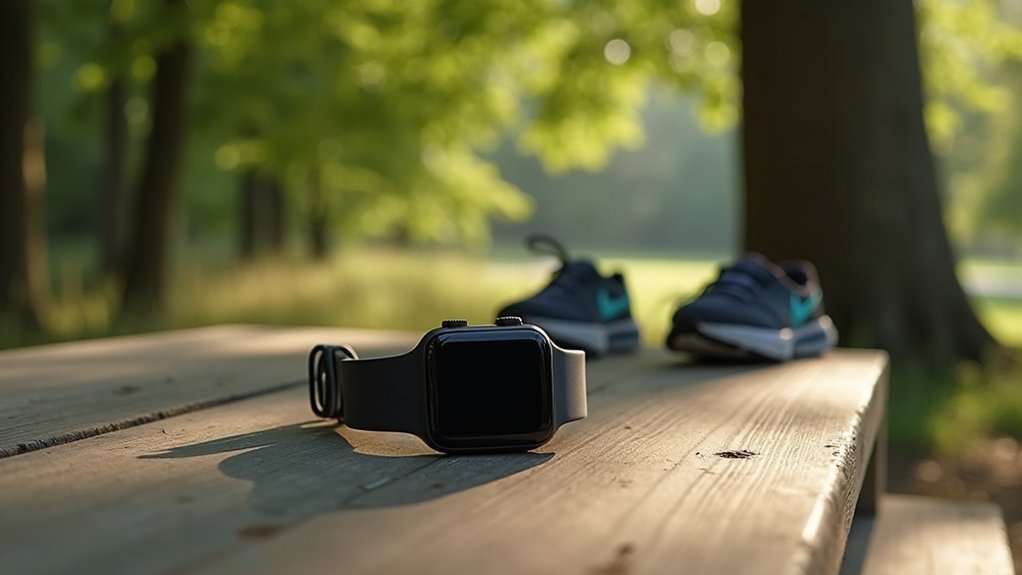You’ll maximize your training effectiveness when you customize pace alerts to match your specific zones and goals. Default settings won’t account for terrain changes, weather conditions, or your recovery needs, leading to overexertion or suboptimal workouts. Customized alerts prevent injury by keeping you within safe boundaries during easy runs while ensuring you hit target intensities for speed work. They adapt to hills, temperature changes, and your current fitness level. Proper configuration transforms your watch into an intelligent coaching tool that guides every step.
Real-Time Pace Monitoring Delivers Instant Feedback

Real-time pace monitoring transforms your running experience by delivering immediate feedback that keeps you informed about your performance as it happens.
This instant data stream allows you to make split-second adjustments to your cadence and footstrike, reducing joint loading and injury risk. You’ll receive immediate alerts when you’re overexerting yourself, helping prevent fatigue-related biomechanical faults before they develop into injuries.
The technology provides objective measurements of your pace consistency, enabling you to compare current performance against previous workouts.
You can precisely maintain target speeds during interval training and races, which is critical for optimization. This immediate feedback also keeps you mentally engaged throughout your run, reducing fatigue while providing tangible evidence of progress that motivates continued effort. However, GPS signal reflection in urban environments can create inconsistencies that may affect the reliability of your pace data.
Target-Specific Training Zone Optimization
You’ll achieve better results when your pace alerts align with specific training zones that target distinct physiological adaptations.
Setting zone-specific pace boundaries lets you stay within ideal intensity ranges, whether you’re building endurance in Zone 2 or developing speed in higher zones. Personalized training leads to significant performance improvements when you maintain consistent effort within your target zones.
Integrating heart rate data with pace alerts and adapting settings based on your workout type guarantees each session delivers the intended training stimulus.
Zone-Specific Pace Boundaries
When you establish zone-specific pace boundaries, you’re creating precise physiological targets that optimize your training adaptations for specific performance goals.
Your Zone 2-4 boundaries focus on aerobic endurance development, perfect for building your base fitness. Zone 6 targets your anaerobic threshold through tempo runs, while Zone 8 pushes you toward VO2 max to enhance aerobic capacity. Zone 10 boundaries are designed for pure speed training, improving neuromuscular coordination.
You’ll benefit most when your threshold pace falls between 85-90% of VO2max. Set your Zone 3 tempo at 106-113% of lactate threshold pace, and Zone 4 subthreshold at 101-105%.
These specific boundaries guarantee you’re training the right energy systems without overreaching, maximizing adaptations while preventing overtraining injuries. Proper workout structure with warm-up, interval, and cool-down segments ensures your body transitions safely between different intensity zones throughout each training session.
Heart Rate Integration
While pace boundaries establish your training framework, integrating heart rate data transforms these zones into precise physiological targets that respond to your body’s real-time demands.
You’ll discover that Zone 2 training (60-70% HRmax) optimizes fat burning and builds aerobic capacity, while Zone 4 intervals (80-90% HRmax) target your lactate threshold. This personalized approach prevents overtraining by adjusting intensity based on your body’s current state rather than predetermined paces.
Heart rate integration enables efficient training distribution—spending 40-50% of your time in Zone 2 for endurance, 10-15% in Zone 3 for tempo work, and minimal time in high-intensity zones.
You’ll achieve better performance outcomes because your alerts adapt to factors like weather, fatigue, and stress that affect your physiological response. Advanced athletes can maximize their aerobic gains by incorporating cruise intervals that strategically maintain extended time in Zone 4.
Workout Type Adaptation
Each workout type demands distinct physiological adaptations that require precisely calibrated pace alerts to maximize training effectiveness.
Zone 1 and 2 endurance runs need alerts that maintain aerobic threshold, developing capillary density and fat oxidation over extended durations. You’ll build your aerobic base through prolonged, low-intensity efforts lasting 60-300+ minutes. Zone 1 training should comprise the majority of your weekly volume, representing 60–80% of your total training time.
Zone 3 tempo runs require steady but challenging pace alerts to train lactate buffering mechanisms and improve your sustainable high-intensity pace. These workouts enhance your VO2 max through 1-5 minute intervals at roughly 5k race pace.
Zone 4 sprint sessions benefit from alerts regulating short, powerful efforts with long recoveries. You’ll develop neuromuscular speed and explosive power through 10-400m intervals.
Tailoring alerts prevents going too fast on endurance days or too slow during speed work.
Injury Prevention Through Smart Pace Boundaries
Smart pace boundaries act as your digital safety net, preventing the overexertion and burnout that derail countless training plans.
You’ll maintain sustainable effort zones that keep your body adapting without breaking down, while monitoring recovery paces guarantees you’re not pushing too hard when your muscles need healing time.
These customized alerts transform your watch into an injury prevention tool that knows exactly when to rein you in before damage occurs. Research shows that runners who increase their weekly distance by 20% to 60% face significantly higher injury rates within just three weeks, making controlled progression essential for long-term success.
Preventing Overexertion and Burnout
Although running delivers incredible physical and mental benefits, approximately 65% of regular runners experience injuries annually, with most occurring in the foot, ankle, and knee regions.
You’re particularly vulnerable if you’re pursuing performance goals or increasing your run volumes, as these factors greatly elevate injury risk.
Overexertion doesn’t just cause physical harm—it leads to burnout that can force you to stop running temporarily or permanently. Workplace injury data shows that overexertion events consistently rank among the leading causes of time away from activities, highlighting how pushing physical limits creates measurable consequences across all forms of human movement.
You can prevent this by customizing your pace alerts to maintain safe intensity levels. When you manage your training load properly, you’ll actually reduce injury risk even at higher volumes.
Smart pace boundaries act as your safety net, preventing the stress fractures, shin splints, and plantar fasciitis that result from pushing too hard too fast.
Safe Recovery Pace Monitoring
Recovery pace monitoring transforms your running watch from a simple timer into an intelligent injury prevention system.
When you maintain a pace that’s 3+ minutes slower than your race pace, you’ll facilitate active recovery while reducing stress on muscles, bones, and tendons. Smart pace alerts keep you within these safe boundaries, preventing the common mistake of running too hard during recovery sessions.
Your wearable technology can integrate physiological markers like resting heart rate and sleep quality to create personalized pace boundaries. This real-time feedback prompts necessary adjustments before overexertion occurs.
You’ll experience less accumulated muscular damage and reduced tendinopathy risk when you consistently adhere to these slower recovery paces. Elite runners demonstrate this principle, with Kenyan marathoners running recovery runs at paces slower than 9:00 per mile despite their incredible racing abilities. Combined with proper education about pacing strategies, these intelligent alerts guarantee your body can repair micro-injuries effectively.
Sustainable Effort Zone Management
When you establish sustainable effort zones through intelligent pace boundaries, your training becomes a precision instrument that prevents overexertion while maximizing aerobic adaptations.
Zone 2 training strengthens your heart by increasing stroke volume and capillary density, enhancing oxygen delivery while reducing resting heart rate. This zone introduces stride variability that reduces musculoskeletal injury risk by distributing stress across different tissues.
You’ll develop metabolic flexibility, allowing better energy utilization during runs while expanding aerobic capacity. Zone 2 prevents overtraining through consistent, moderate pacing that newer exercisers particularly benefit from. Traditional calculation methods rely on broad assumptions, but personalized data creates more accurate training zones that reflect your unique physiology and fitness level.
When you shift to Zone 3, you’re recruiting Type IIa muscle fibers and increasing lactate threshold through intense aerobic effort. Customizable pace alerts guarantee you stay within ideal zones, creating smarter workload management that reduces injury risk.
Enhanced Workout Focus and Motivation
By customizing your running pace alerts, you’ll transform scattered workout sessions into laser-focused training opportunities that keep you locked onto your performance goals.
When you’ve got precise feedback coming through your earbuds, you can’t help but stay engaged with your workout intensity and pacing strategy.
Your customized alerts create a powerful motivation loop that keeps you pushing forward:
- Real-time performance tracking helps you hit specific distance, speed, and frequency targets during each session
- Data-driven goal achievement lets you forecast upcoming performance and celebrate measurable progress
- Social sharing capabilities allow you to compare metrics with friends and draw inspiration from their achievements
This technological advantage turns every run into an interactive experience where you’re constantly aware of your effort levels, preventing both underperformance and dangerous overexertion. Regular analysis of your pace data enables you to refine training plans that evolve with your improving fitness levels and changing performance objectives.
Terrain-Adaptive Alert Configuration

Your running pace alerts can automatically adjust to terrain changes, helping you maintain consistent effort rather than rigid speed targets.
When you’re tackling hills, the system modifies your target pace based on gradient data, ensuring you don’t overexert on climbs or underutilize descents.
Weather conditions like rain, snow, or extreme heat also trigger alert recalibration, keeping your pacing strategy aligned with safety and performance goals. These recurring alerts can be configured to notify you at regular distance intervals, ensuring you receive consistent feedback throughout your changing terrain conditions.
Hill-Specific Pace Adjustments
Although traditional pace alerts work well on flat terrain, they become counterproductive when elevation changes dramatically alter your running dynamics.
Hills demand a completely different approach to pacing that focuses on effort rather than speed.
Your GPS watch can automatically adjust pace targets based on real-time elevation data, preventing early exhaustion on climbs and reducing injury risk on descents.
Every 10 feet of elevation gain shifts your running time by approximately 1.74 seconds per mile, making manual calculations impractical during runs.
Hill-specific adjustments offer several advantages:
- Uphill alerts prompt you to maintain 85-90% effort while accepting slower speeds
- Downhill notifications encourage controlled pacing to minimize muscle damage
- Grade-Adjusted Pace calculations translate your hilly performance into flat-ground equivalents for accurate training analysis
Understanding that hilly courses are inherently slower than flat courses helps explain why these terrain-adaptive alerts are essential for realistic pacing expectations during challenging elevation profiles.
Weather Condition Adaptations
Weather conditions create performance challenges that extend beyond elevation changes, demanding pace alert systems that respond to temperature, humidity, wind, and solar radiation in real-time.
You’ll perform best between 50°F and 63.5°F, with each degree deviation reducing your speed by 0.3-0.4%. Above 60°F, expect 20-30 seconds slower per mile for every 5°F increase.
High humidity impairs sweat evaporation, amplifying heat stress effects. Use this formula: Base Pace + [(Dew Point°F – 60) × 0.025] for humidity adjustments.
Direct sunlight increases core temperature faster than shaded conditions, while headwinds create aerodynamic drag requiring more energy. Cloud cover provides significant relief on hot days by reducing solar radiation exposure.
Your pace alerts should integrate Wet Bulb Globe Temperature readings, which combine all weather parameters for accurate performance predictions and real-time pace modifications.
Device-Specific Alert Capabilities and Limitations
When selecting a running watch for pace alerts, you’ll discover that devices vary greatly in their alert capabilities and customization options. Entry-level models like the Garmin Forerunner 55 offer basic pace and cadence alerts but lack advanced features found on premium devices.
Your device’s GPS accuracy directly impacts alert reliability, with higher-end watches providing faster update rates and more precise notifications.
Consider these key limitations when choosing your device:
- Alert customization depth – Basic models offer preset options while advanced watches allow fine-tuning sensitivity and thresholds
- Multiple alert support – Not all devices can simultaneously track pace, speed, and cadence alerts
- Notification delivery – Visual cues, vibration intensity, and audible tones vary greatly between manufacturers
Your device’s sensor compatibility and third-party app support ultimately determine your pace alert effectiveness. Premium models with AMOLED displays offer superior visibility for pace alerts in bright sunlight conditions.
Heart Rate Integration With Pace Thresholds

Beyond basic pace notifications, modern running watches excel at combining heart rate data with pace thresholds to create intelligent training zones that adapt to your physiological state. You’ll achieve better results when your device alerts you based on both metrics simultaneously, ensuring you’re training at the ideal intensity for your fitness goals.
| Training Zone | Heart Rate % | Pace Relationship | Primary Benefit |
|---|---|---|---|
| Zone 3 (Threshold) | 70-80% max HR | Marathon to 10K pace | Aerobic capacity improvement |
| Zone 4 (VO2 Max) | 83-88% max HR | 5K to 3K pace | Lactate buffering efficiency |
This integration prevents you from running too fast when your heart rate’s elevated or pushing harder when your body can handle increased intensity. You’ll maintain steady lactate states more effectively, leading to improved endurance and performance gains. Unlike VO2 max which plateaus, your lactate threshold can be consistently improved through targeted training with properly configured pace and heart rate alerts.
Recovery Run Pace Management
Recovery runs form the foundation of sustainable training programs, yet they’re often the most challenging workouts to execute properly.
You’ll find yourself naturally wanting to push harder, but customizing your pace alerts prevents this common mistake. By setting alerts 3 minutes per mile slower than your race pace, you’ll maintain the gentle aerobic engagement needed for proper recovery.
Effective recovery run pace management requires strategic customization:
- Environmental adjustments – Modify alerts based on terrain, weather, and altitude changes
- Body signal awareness – Override alerts when fatigue or soreness demands even slower pacing
- Technology integration – Use GPS watches to maintain consistent pacing without constant effort
This approach optimizes blood flow for muscle repair while preventing overtraining, ensuring you’re ready for your next challenging workout. While many runners believe these sessions directly accelerate muscle recovery, the true value lies in building aerobic conditioning and maintaining training consistency.
Race Preparation Through Consistent Pacing
While recovery runs teach you restraint, race preparation demands precision through consistent pacing that transforms your body into a finely-tuned performance machine. You’ll optimize fuel use, delay fatigue onset, and build the mental conditioning needed for race day success.
| Training Method | Physiological Benefit | Performance Impact |
|---|---|---|
| Interval training at race pace | Enhances aerobic capacity | Improves race times |
| Tempo runs at target speed | Strengthens energy systems | Reduces “hitting the wall” |
| Long runs at race pace | Builds endurance comfort | Achieves personal bests |
Customized pace alerts become your strategic advantage here. They’ll keep you from starting too fast, provide real-time feedback for adjustments, and reduce the mental load of pacing decisions. You’ll develop proper race pace sensations while building confidence that translates directly into race day performance. Since no universal pace fits all runners due to varying individual capabilities and goals, personalized alerts ensure your specific training needs are met rather than following generic recommendations.
Alert Mode Customization for Different Environments
As terrain shifts beneath your feet and environmental conditions change around you, your pace alert system must adapt accordingly to maintain training effectiveness.
You’ll need to adjust alert thresholds based on GPS accuracy variations between urban canyons and open rural paths.
Your watch’s segment-based alerts become significant when tackling different terrains, calculating average pace for each workout portion. Early in segments, alerts are more sensitive due to volatile average speed readings with limited distance data.
Segment alerts require patience—early readings fluctuate wildly before GPS data stabilizes into reliable pace averages.
Consider these customization strategies:
- Variable thresholds – Adjust GPS-dependent alerts for city versus countryside running
- Terrain-specific targets – Set different pace ranges for hills, trails, and flat roads
- Weather adaptations – Modify alert sensitivity for wind, heat, or precipitation conditions
Manual adjustments prove essential during interval training when you’re switching between recovery and high-intensity pace ranges. The speedometer display provides real-time feedback showing your current pace alongside your target range, making these transitions more intuitive.
Preventing Pace Drift During Long Runs
During extended runs lasting longer than an hour, your body undergoes predictable physiological changes that can sabotage your pacing strategy if you’re not prepared.
Cardiac drift causes your heart rate to climb progressively even when you maintain the same effort level, creating a misleading signal that you’re working harder than intended.
You’ll naturally compensate by speeding up when relying solely on perceived effort, which leads to unwanted pace drift.
Smart pace alerts prevent this by providing objective feedback when your speed increases beyond your target range. Set your alerts to trigger early warnings before significant drift occurs, allowing you to make subtle adjustments rather than dramatic corrections.
This strategy becomes especially important during longer training runs where maintaining consistent pacing builds proper race-day habits and prevents premature fatigue. Proper hydration management before and during your run helps minimize the effects of cardiac drift by preventing excessive stroke volume decline.
Interval Training Precision With Upper and Lower Limits
When you’re executing interval workouts, precision becomes critical for achieving your training objectives without compromising your body’s ability to recover between efforts. Setting upper and lower pace limits transforms your watch into an intelligent training partner that keeps you disciplined throughout each segment.
Custom alerts prevent the common mistake of starting intervals too aggressively, which leads to premature fatigue and compromised performance in later repetitions. They also guarantee you’re pushing hard enough during work phases to stimulate the intended physiological adaptations. This functionality reduces anxiety about tracking performance metrics since the watch provides automatic notifications when you drift from your target zones.
- Enhanced focus: You’ll concentrate on form and breathing instead of constantly checking your pace
- Consistent execution: Each interval maintains the same intensity for balanced training stress
- Real-time corrections: Immediate feedback allows quick adjustments before drifting too far from your target zone
Weather and Condition-Based Alert Adjustments
Since temperature ranks as the most significant weather factor affecting running performance—with a 40% importance score—your pace alerts need dynamic adjustment capabilities that respond to environmental conditions.
You’ll perform best between 44°F and 59°F, but when temperatures climb above 60°F, add 20-30 seconds per mile for every 5°F increase to your alert thresholds.
Humidity also demands attention, holding a 26% importance factor that affects your perceived effort.
Solar radiation contributes 18% to performance impact, while wind speed accounts for 16%.
For each degree increase in WBGT (Wet Bulb Globe Temperature), expect your pace to slow by 0.3-0.4%. At higher elevations above 5,000 feet, decreased oxygen availability further reduces endurance and performance times.
Configure your alerts to automatically adjust thresholds based on real-time weather data, preventing frustration when conditions naturally slow your performance.
Frequently Asked Questions
How Do I Reset My Pace Alert Settings to Factory Defaults?
You’ll reset pace alert settings by holding the UP button, steering to Menu → System → Reset, then selecting “Reset Default Settings.” This restores factory defaults while keeping your activity data intact.
Can I Set Different Pace Alerts for Left and Right Foot Cadence?
You can’t set different pace alerts for left and right foot cadence. Current running watches don’t differentiate between individual feet movements, only monitoring your overall cadence for balanced running form.
Do Pace Alerts Drain Battery Life Significantly on GPS Watches?
Yes, pace alerts considerably drain your GPS watch’s battery. Each alert triggers vibrations and backlight activation, consuming more power than GPS tracking itself. You’ll notice shorter battery life with frequent pace alerts enabled during workouts.
Which Running Apps Sync Best With Third-Party Pace Alert Devices?
MapMyRun syncs best with third-party devices due to its broad compatibility with wearables and sensors. You’ll also find Pace Control works well with Bluetooth headsets, while The Pace App integrates seamlessly with Apple Watches.
How Often Should I Recalibrate My Watch for Accurate Pace Alerts?
You should recalibrate your watch regularly, ideally after stride changes, software updates, or before important races. Recalibrate when environmental conditions change markedly or if you’ve made hardware adjustments to maintain accuracy.





Leave a Reply